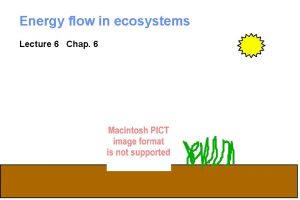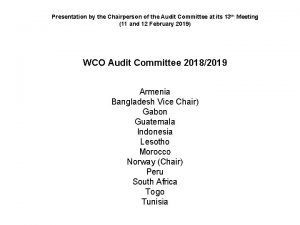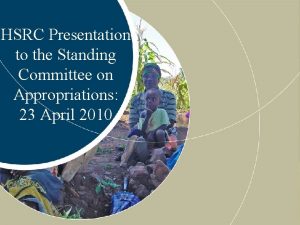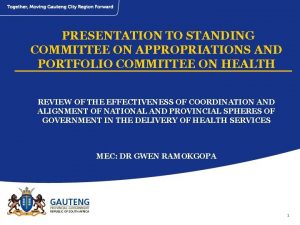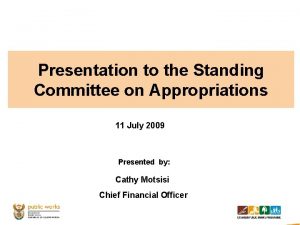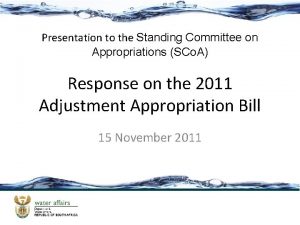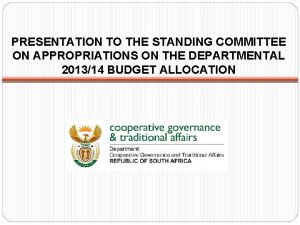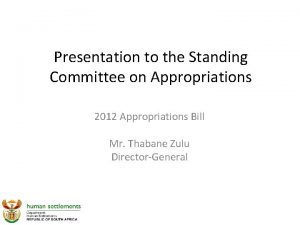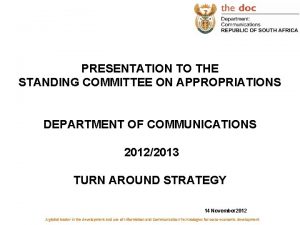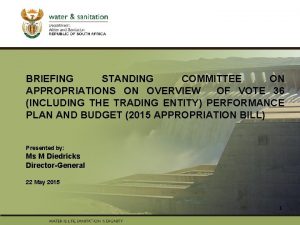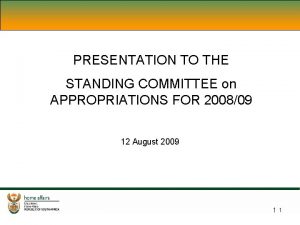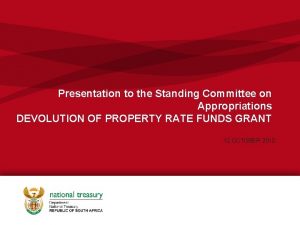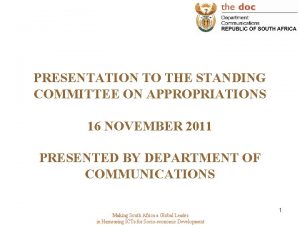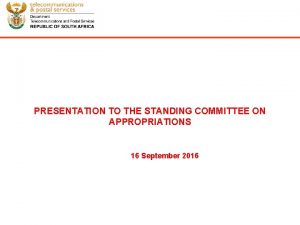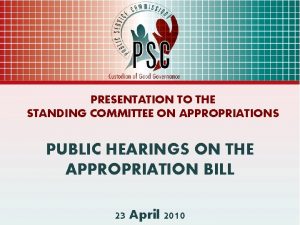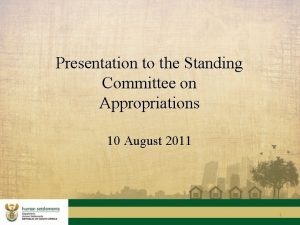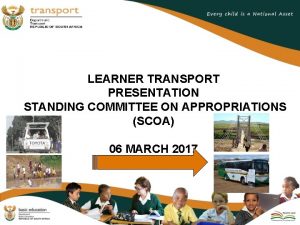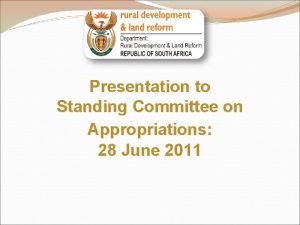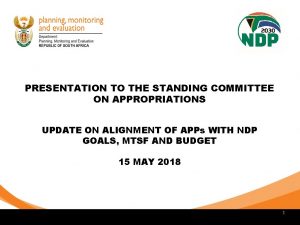Presentation to the Standing Committee on Appropriations 11








































![Crime and Particularly Violent Crime is Typically a Male Youth Enterprise [1]. • Youth Crime and Particularly Violent Crime is Typically a Male Youth Enterprise [1]. • Youth](https://slidetodoc.com/presentation_image_h2/14b984eb78992eac701fc429ac031a49/image-41.jpg)






- Slides: 47

Presentation to the Standing Committee on Appropriations 11 May 2010

Outline 1. Creation of decent work and sustainable livelihoods 2. Education 3. The fight against crime

Decent Work and Sustainable Livelihoods

Decent work & sustainable livelihoods • HSRC coordinates Employment Scenarios, to draw together vision of how sufficient employment can be created that is sustainable and that enables sufficient earnings • Key insights: main sources of job creation • It is critical that the growth path shift from trade in basic metals and minerals, to one with higher knowledge intensity and value added • Increasingly more employment should be sourced from these future industries • This will require the continued commitment to achieving world class infrastructure, especially in energy, water, telecoms, commercial transport. The HSRC found that unemployment could have been 25% lower had commercial transport and telecoms been globally competitive. • SA cannot compete on cost alone – therefore emphasis on R&D, product development, venture capital, and market access arrangements are essential. • Globally, most jobs come from services in urban areas. This depends on crowding in of linkages through business support, appropriate human settlements and functional commuter transport, and human development.

Decent work & sustainable livelihoods • Challenges • To date, the majority of employment created in cyclical sectors such as retail, security, cleaning and construction. SA has not convincingly shifted towards value added trade that will enable long term employment and real wage growth • The market can only expand so fast, in the context of the massive backlog of unemployed. In this context, Government employment schemes essential • SA lost about 1 million jobs in 2009/10. Worst hit were youth under the age of 30, and those with less than a matric.

Decent work & sustainable livelihoods • Policy implications • In most key areas, spending commitments made. More essential question is whether performance and value for public spending can be achieved. • Continued commitment to infrastructure spending is essential. However, discipline needed to review capital expenditure requirements and operational efficiency in the state owned enterprises. • It is critical that resources be applied to reducing the cost of doing business. For example, the cost of regulatory compliance could be reduced, with SARS being held up as solid example. The aim is to make compliance easier and simpler. Examples include EIAs, audit requirements of small firms, compliance to BEE, Employment Equity and skills development regulations, or accessing skills levy funding.

Decent work & sustainable livelihoods • More dramatic attention to challenge facing youth in accessing post schooling opportunities is needed • Financial contribution to culture and recreation reduced. This could be critical pre-labour market intervention in context where youth marginalised from most social organisation • Commitment to enlarging FET is limited to 1/3 of the original Dept of Education commitment to doubling FET enrolments. Pulling youth out of the labour market and into learning opportunities especially in the downturn will be critical strategy. • While public sector employment expanded in 2007/8 and 2008/9, it is possible that the new salary adjustments will dramatically slow this expansion and promote rising skills intensification. The public sector globally plays an important role as a first employer, but is unlikely to do so in coming years unless explicit strategies are put in place, such as strategies to deepen the job hierarchies to hire more people in lower grades as (for eg) clerks to relieve professionals. In addition, we recommend the introduction of a youth transitional jobs scheme. • Continued commitment to EPWP II and the Community Works Programme is welcomed, as put forward in the statement. Serious attention will be needed to ensure these programmes expand.

Food security - status • The HSRC has recently completed overview of available evidence on household food security. We support the Integrated Food Security Strategy, and are establishing policy, strategy, monitoring and evaluation systems • The available evidence points to very high levels of food insecurity. • The social grants have had a dramatic effect in reducing severe hunger. In 2007, 12% of children sometimes or always experienced hunger, down from 20% in 2002. • Under-nourishment is however widespread: • Approx 50% of households experience hunger and under-nutrition (i. e. they have insufficient energy intake and inadequate intake of several micronutrients (iron, vitamin A, zinc); an additional 25% of households are at risk of hunger (NFSC 2005) • Child stunting has fallen from 24% in 1999, to 21% in 2005. This is still unacceptably high • Our review of official data shows that 50 to 80% of households could not afford minimum nutrition at current prices and levels of fortification. It is cheaper to consume a high calorie, low nutrient food basket than it is to fill up on a high nutrient one • Rural households spend 9% to 15% more than urban ones for the same basic food basket • Hunger is not a “rural challenge” alone, instead it is a national one: the biggest concentrations of severe hunger are found in 4 metros – CT, Ekhurhuleni, Joburg and OR Tambo.

Food security – policy challenges • More attention is needed for nutrition programmes, but design still needed • Many key items already on budget (please see attachment), but in some cases need stronger institutional model for delivery. For example: • 51% of all severely hungry households qualify for grants but do not receive them. Policy implication: • Urgent that grants be more fully rolled out, especially to young children • Recent approval to raise the eligibility age of CSG should help • Expansion of household food production to widen food groups consumed • Commitment to vitamin A roll-out is stated, but only 20% of target group reached. We believe more funding required into community based delivery, potentially through provincial departments of social development home/community based ECD programmes • There is a commitment to fortification programmes, but the compounds used (esp iron and vit A) are not appropriate. More attention to industrial incentives to encourage firms to fortify using appropriate compounds needed, along with funding for monitoring and evaluation

Food security • Combination of policies – impact not sufficient • Policy complements include: nutrition programmes (fortification, school feeding schemes, National Nutrition Supplementation programme); competition policy; support for household production, etc • Currently not possible to extract a ‘food security budget’ that can be monitored • Most funding targeted at nutrition allocated through provinces, with great uncertainty about whether spent as intended by national policy. • Policy implication: • Urgent attention to complement of policies to improve nutrition status and food security • Affordable nutritious food must be made available on a regular basis – this will involve attending to food price levels and stability, as well as strengthening nutrient supplementation and food fortification • Budgets aimed at improving food security should be ring-fenced and monitored • Reliable, nationally representative and regular monitoring and evaluation systems of household food security nationally are urgent and essential

Rural development • HSRC’s research investigates approaches to improving food security and expanding livelihoods especially through small scale agriculture. • Small % of rural population economically active, and especially not in agriculture • More than 40% of population live in rural areas, but less than 10% of economically active are engaged in agriculture • Typically closer to 80% of the rural adult population involved in agriculture. Even in developed countries can be approximately 25% • Economic participation is generally very low, especially in former bantustans

Rural development • Policy implications: • Growing spending on rural development from R 6 bn to R 8 bn by 2012/3. This is large increase but still very small relative to the challenge and levels of neglect. • Agricultural support budgets allocated to provinces are also very small. In 2008/9, average agricultural expenditure per landed household was R 3, 700. • Critical attention is required to: • Improve water management, water reticulation, water retention schemes • Land management and care, and environmental services • Agricultural support and extension to both commercial and household production • Research and development for both commercial farming and household production • Expanded processing nearer to agricultural producers where economically justified • Attention to inputs costs, such as fertiliser and equipment • More forceful export market development • Meaningful expansion of agricultural training colleges • Investment in agro-industrial logistics platform – such as rural roads and ability to export timesensitive products • Very weak monitoring and evaluation of small holder farming.

Rural Development and Land Reform • A conceptual and strategic framework for a Comprehensive Rural Development Program (CRDP) drafted • The strategy has outlined and clarified the following issues: • The Mandate for Rural Development and Land Reform • 3 pronged strategy for CRDP which includes • Agrarian Transformation; Rural Development & Land Reform • Fast-track expansion of ‘rural development pilot sites or nodes’

Rural Development and Land Reform • Policy & capacity issues which include: • The development of a White Paper on Agrarian Transformation, Rural Development & Land Reform • The Green Paper is to be tabled in cabinet shortly • Rural Development Agency (RDA) to co-ordinate implementation • Overhaul land policy framework & consolidate all land-related laws • A revised tenure security law for farm workers • Fix collapsing land reform projects through the land reform recap intervention- combined with CASP critical to sustain rural livelihoods • DRDLR Green Paper to be released, and we recommend follow up session once that is done to review proposals and their implications

WOMEN, URBANIZATION AND SETTLEMENT Women entering the labour force accounted for most of SA’s employment growth over 1995 -2005 (DPRU 2007) Now employment is falling – and women dropping out of the workforce have shot up 44% since 2008 (LFS Q 4 2009) Are the women who need work now able to reach the jobs they need? • Current international research (Bertaud, 2008) spotlights urban spatial location in relation to reaching job markets – • Where people can settle in the city determines how far workers need to travel to reach jobs • For the poor, the journey to work can limit their chances for economic participation • South Africa’s transport subsidies are extensive – but directed to the working poor, not to the unemployed Does this policy approach work for women work-seekers and their families?

IPDM Survey Data CPEG research results (2008) suggest that urbanizing women may not usually achieve economic participation • South African compact city planning prioritizes bringing the poor into the city core zone to cut transport costs and help them reach work Is the compact city model effective for women and their families? Data on spatial settlement and economic outcomes is from the Phase 1 a IPDM survey – • • Ongoing R 30 m project from DST, CSIR, HSRC Phase 1 a = 2965 questionnaires, Gauteng, Sekhukhune and northern Mpumalanga 2007/8 • Analysis compared women-headed to men-headed households, & also to households with no definite head – youth with roommates, etc • Aimed at economic outcomes for where women’s households live when they move to town • In relation to their spatial access to earning opportunities Research suggests the types of settlement where women concentrate are often marginalized for earning opportunities

No Advantage for Women? Poor women settling in cities concentrate in the urban backyards, subsidy housing and outer shacks – • Township housing is now too crowded for in-migration • These areas are mostly peripheral, marginal for transport and for work access • For these urban settlements, women’s per capita household income was similar to rural women’s households • Highest estimated per capita urban income for women’s households not in townships was R 383 per month – • That’s not much higher than the inner rural villages at R 370 This result suggests little advantage to women from urban migration • Overall mean urban income for women with families was R 502 per capita including the townships • But men’s households reached R 757 • Young women on their own in ‘headless’ households earned more than women with families at R 610

Decent Work For Women? Facing spatial exclusion, can women work seekers find decent work? • IPDM findings show that most women with families do not succeed • ‘Decent work’ can be benchmarked at R 2500/m for a wage earner with 4 -5 dependents – about R 2 person per day No kind of household met this standard, or came close But women with families looked much worse off than men – • Only 12 % of earners in women-headed households even reached R 2000/m • Against 29 % in men-headed households • Younger women postponing family life met male-head earners at 30 % To meet this spatial-access challenge may need new policy approaches to urban transport services & transport subsidization WAGE INCOME /m MALE HEAD FEMALE HEAD ‘HEADLESS’ Under R 1000 52 % 74 % 57 % R 2000+ 29 % 12 % 30%

Women’s Geography? population % womenheaded households Old traditional rural areas 10 52 Modern rural villages 9 41 Rural shack areas 3 47 Urban periphery shack areas 15 26 Metro core zone shack areas 3 27 Old urban townships 27 40 Backyard accommodation 2 46 Urban rentals 0. 5 35 SETTLEMENT TYPE % of study area

Poverty Outcomes? GENDER OF HEAD % 20 -64 unemployed, urban households % 20 -64 unemployed, rural households Per capita income, urban income, households rural households Womenheaded households 40 54 R 502 R 337 Male-headed households 36 50 R 757 R 391 Households with no designated head 48 45 R 610 R 254 Total IPDM survey sample 41 50 R 623 R 327

Education: Basic and Higher

Budget for Basic Education 2010/11 R million Total to be Appropriated MTEF allocation Administration Curriculum Policy, Support and Monitoring 252. 8 1354. 3 Teachers and Education Human Resources Development and Management 513. 7 Planning, Quality Assessment and Monitoring and Evaluation 148. 7 Social Responsibility 3896. 7 Total Expenditure Estimates 6166. 2

National and Provincial Budget for Basic Education • The national department of education is responsible for policy development; coordination, monitoring and evaluation. • The provincial department of education is responsible for the implantation of programmes in schools. • Because we are not evaluating the provincial budgets we cannot comment on the delivery of educational services.

HSRC Research on Basic Education • Research is located within the challenges faced in South African education, in Africa and the developing world. These challenges are linked to the education and development trap. • Challenges in Education: access, equity, quality and efficiency. These lead to unequal educational outcomes.

HSRC Research on Basic Education (continued) • Despite significant efforts in the past decade, we have not succeeded in ensuring that the majority of the population, who are still living in poverty, are equipped with the capabilities promised by democracy and development.

FINDINGS FROM HSRC RESEARCH

Education and Development

Progression Rates from Gr. 8 to 12

Early Years of Schooling 1. Cognitive Performance at an early age (6 years) can predict later performance, especially in mathematics. 2. If we want to change the predictable course of educational development for an individual we have to intervene and invest in the early years, both in and out of school initiatives.

Literacy & Language Teaching and Acquisition • Strong quality mother tongue literacy development is essential for literacy, academic language & numeracy skills. • Learners do not read and write enough. • The use of textbooks, readers & other materials neglects progression and connection across the curriculum (other learning areas).

Comment on budget • For Basic education we need to consider both the national and provincial budget. • Budgets need to emphasize a few key areas: foundations for learning programmes; training of high quality teachers of African languages; how we keep young people in school & training institutions. • No fee school policy is helpful intervention in the education and development trap.

Budget for Higher Education & Training 2010/11 R million Total to be Appropriated MTEF allocation Administration Human Resource Development, Planning and Monitoring Coordination University Education Vocational and Continuing Education and Training Skills Development Subtotal 100. 5 26. 0 19534. 7 3891. 2 168. 3 23720. 7 Direct charge against the National Revenue Fund Sector education and training authorities 6739. 4 National Skills Fund 1684. 8 Total Expenditure Estimates 32144. 9

FINDINGS FROM HSRC RESEARCH

Vocational Education and FET colleges • Major audit of all 50 colleges underway to ascertain college readiness for requirements of new Act. • Data being collected on college governance, management and administration, on student and staff profiles, and on efficiency indicators.

Research on transitions from school to higher and further education and to workplaces • HSRC has conducted a number of pathway studies over a decade. • In the case of school and college transitions to the labour market, very low absorption of graduates, and in the case of higher education transition to the labour, low absorption of black African non-completers and graduates. • High volatility amongst the youth – learner aspirations failing to translate into student enrolments, and a large degree of student mobility within and attrition from the higher education system.

Budget comment • The combination of education and training into Ministry is positive for skills development. • FET colleges are important sites for intermediate skills development. The budget allocation for FET colleges requires serious review: for 2010/11, the total to be appropriated is R 19, 534 b for universities, R 3, 891 for FET colleges. • In the context of the DHET aim of growing FET college enrolments to 1 m students and ultimately of realising a healthier ratio of university to FET college enrolments in line with international comparators, this ratio needs to be addressed.

The fight against crime

HSRC’s Research on Violent Crime Driven by two broad research questions: • Within the resource constraints of countries in the global South, what interventions are appropriate and effective in order to create sustainable, safe and secure communities? • How does violent crime impact the consolidation of democracy, the legitimacy of the state and the creation of socially cohesive communities?

HSRC’s Research on Violent Crime • • Study of Violent Offenders (2007 -2008) Study of Social Cohesion and Violence, with case studies in the Western Cape, Gauteng and KZN (2008 -2009) Workshop focusing on African Local Government responses to Violent Crime (with UN-Habitat and UCLGA) (2008) Study on Fear and Citizenship (2009) Workshop on comparative international experiences reducing Violent Crime in Africa, Asia and Latin America (book forthcoming) Hosted the former Mayor of Bogota (succesful case study of crime reduction), Prof. Antanas Mockus on a tour of South Africa to meet with policy makers (March 2009) Study tour to Brazil and Colombia – collaboration with Latin American institutions (April-May 2009) Study on Human Trafficking in Southern Africa (March 2010)

Violent crime in South Africa • South Africa has one of the highest murder rates in the world. • Latest crime statistics released by the South African Police Services for April 2008 -March 2009 put South Africa’s murder rate at a total of 18, 148, which is a ratio of 37. 3 murders per 100 000 of the population. • Young men form the bulk of offenders and victims of crime • Violent crime is significantly characterised by violence between people who know each other either as friends, relatives or acquaintances. • Violent contact crime is primarily social in nature and falls outside the realm of conventional policing.
![Crime and Particularly Violent Crime is Typically a Male Youth Enterprise 1 Youth Crime and Particularly Violent Crime is Typically a Male Youth Enterprise [1]. • Youth](https://slidetodoc.com/presentation_image_h2/14b984eb78992eac701fc429ac031a49/image-41.jpg)
Crime and Particularly Violent Crime is Typically a Male Youth Enterprise [1]. • Youth in South Africa are twice as likely as adults to be victims of at least one crime. • The age of first offence in South Africa is extremely young; 43. 5% of offenders reported that they had committed their first criminal act at 10 -15 years; 35. 9% at 16 -18 years and 18. 7% at 19 -25 years. • Homicide, primarily involving firearms, is the leading cause of death among young men between the ages of 15 -21. [2] • Young males are more at risk of becoming victims of crime and violence with almost one out of two (46%) males reporting victimization, compared to 37% of young females. [3]

Government’s Approach to Crime and the Way Forward The National Crime Combating Strategy has recognised the need to address the root causes of crime. • The police budget will climb to R 56. 3 bn in the 2010 -2011 financial year, from R 50. 9 billion in the past financial year and R 44 billion in 2008/9. • In April 2011 the police budget, according to the MTEF, will grow to R 61. 3 billion while in April 2012 it will increase to R 65 bn, an 8. 5% growth in three years. • R 56. 5 bn will be allocated to the police to increase staff to 200, 660 from 185, 000 by 2012/2013. • R 680 mil will be spent on boosting detective services, crime intelligence and visible policing. • The “Hawks’ will receive R 150 mil of R 78. 4 bn allocated for public order and safety. R 12. 9 bn has been allocated to improving efficiency of the courts. •

Towards a National Crime Prevention Strategy PREVENTION – Working with Youth • Preventing crime, as opposed to merely responding to it through the criminal justice system, significantly reduces the negative social impact of crime and is cost effective because it reduces the burden of work on both the courts and police, as well as the burden of crime on the health system. • Generalised deterrence is not effective –targeted early preventative intervention is key. Early prevention programmes include programmes that focus on building functional families. • Systemic support to sustain early intervention is equally important Programmes here focus primarily on safe schools and post-school activities, especially the transition from school to employment.

Policy and Budget Implications A challenge is: How do we budget for Social Crime Prevention and monitor success? Currently, we focus on Criminal Justice: e. g. , SAPS & DOJ. But, Social Crime Prevention also requires collective efforts and budgeting by Education, Social Welfare, Economic Development and Youth Development.

Priority areas for budget allocations for Social Crime Prevention In addition to the police allocations, we recommend: • A coherent and sustained family behavioural support programme - focus on dysfunctional and violent households, particularly those headed by young single mothers; • A dedicated and comprehensive early childhood development programme - developmental support to children from dysfunctional households; • Increase and targeted funding for after-school programmes, with courses that offer decision-making skills, interpersonal competence, cultural awareness, self-esteem and drug and alcohol prevention. Targeting these social competencies is shown to have a marked impact on reducing youth criminality.

Priority areas for budget allocations for Social Crime Prevention (Cont) • A mandatory and comprehensive national youth civic service programme - focus on developmental support to young people (15 -25) who are not in the education system or working or who have been released from incarceration. [1] • For young offenders - upgraded and sustained diversion programmes and a monitoring system [2] and a systematic exit and re-integration programmes for those who have been incarcerated. [3] • Subsidize training courses to professionalize police through universities; • Increase the ratio of Social Workers in at-risk communities; • Implement programmes through finding partnerships with NGOs and business.

Final Remarks • It makes financial sense to invest in long term prevention, rather than responding to crime. • It also makes political and social sense to invest in the development of the country’s youth, rather than imprisoning them.
 Difference between standing crop and standing state
Difference between standing crop and standing state P&t committee presentation
P&t committee presentation Audit committee presentation
Audit committee presentation Loan committee presentation
Loan committee presentation Finance committee presentation
Finance committee presentation Phối cảnh
Phối cảnh đặc điểm cơ thể của người tối cổ
đặc điểm cơ thể của người tối cổ Tỉ lệ cơ thể trẻ em
Tỉ lệ cơ thể trẻ em Các châu lục và đại dương trên thế giới
Các châu lục và đại dương trên thế giới ưu thế lai là gì
ưu thế lai là gì Các môn thể thao bắt đầu bằng tiếng bóng
Các môn thể thao bắt đầu bằng tiếng bóng Tư thế ngồi viết
Tư thế ngồi viết Cái miệng nó xinh thế chỉ nói điều hay thôi
Cái miệng nó xinh thế chỉ nói điều hay thôi Hát kết hợp bộ gõ cơ thể
Hát kết hợp bộ gõ cơ thể Mật thư tọa độ 5x5
Mật thư tọa độ 5x5 Tư thế ngồi viết
Tư thế ngồi viết Voi kéo gỗ như thế nào
Voi kéo gỗ như thế nào Thẻ vin
Thẻ vin Thứ tự các dấu thăng giáng ở hóa biểu
Thứ tự các dấu thăng giáng ở hóa biểu Thể thơ truyền thống
Thể thơ truyền thống Từ ngữ thể hiện lòng nhân hậu
Từ ngữ thể hiện lòng nhân hậu Hổ sinh sản vào mùa nào
Hổ sinh sản vào mùa nào Thế nào là hệ số cao nhất
Thế nào là hệ số cao nhất Diễn thế sinh thái là
Diễn thế sinh thái là Vẽ hình chiếu vuông góc của vật thể sau
Vẽ hình chiếu vuông góc của vật thể sau Lp html
Lp html 101012 bằng
101012 bằng Lời thề hippocrates
Lời thề hippocrates Tư thế worms-breton
Tư thế worms-breton đại từ thay thế
đại từ thay thế Vẽ hình chiếu đứng bằng cạnh của vật thể
Vẽ hình chiếu đứng bằng cạnh của vật thể Quá trình desamine hóa có thể tạo ra
Quá trình desamine hóa có thể tạo ra Công của trọng lực
Công của trọng lực Thế nào là mạng điện lắp đặt kiểu nổi
Thế nào là mạng điện lắp đặt kiểu nổi Sự nuôi và dạy con của hươu
Sự nuôi và dạy con của hươu Các châu lục và đại dương trên thế giới
Các châu lục và đại dương trên thế giới Các loại đột biến cấu trúc nhiễm sắc thể
Các loại đột biến cấu trúc nhiễm sắc thể Thế nào là sự mỏi cơ
Thế nào là sự mỏi cơ Bổ thể
Bổ thể độ dài liên kết
độ dài liên kết Thiếu nhi thế giới liên hoan
Thiếu nhi thế giới liên hoan Hát lên người ơi
Hát lên người ơi điện thế nghỉ
điện thế nghỉ Một số thể thơ truyền thống
Một số thể thơ truyền thống Trời xanh đây là của chúng ta thể thơ
Trời xanh đây là của chúng ta thể thơ Sơ đồ cơ thể người
Sơ đồ cơ thể người Số nguyên tố là gì
Số nguyên tố là gì Leopold maneuver
Leopold maneuver
